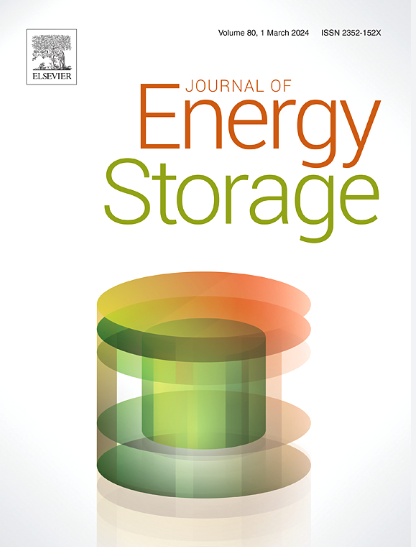柔性固态锌离子电池用硫杂环醌聚合物柔性独立式三明治膜的制备策略
IF 8.9
2区 工程技术
Q1 ENERGY & FUELS
引用次数: 0
摘要
醌类聚合物应用于柔性固态锌离子电池(FSZIBs)面临的挑战是如何设计和制造具有高容量和良好循环稳定性的柔性独立电极。本文提出了一种基于硫杂环醌聚合物(SHQP)的fszbs柔性独立薄膜的两步工程策略,即聚合物纳米线的制备和三明治结构薄膜的构建。采用界面聚合方法首次合成了核/鞘结构碳纳米线nanotube@SHQP(CNT@SHQP),其中SHQP与碳纳米管之间的π-π相互作用促进SHQP自组装,在碳纳米管周围形成薄纳米层。这种独特的纳米结构可以有效地增加活性位点,加速电子转移,缩短Zn2+离子的扩散路径,缓冲体积变化,同时提高SHQP纳米层的结构稳定性。更重要的是,利用CNT@SHQP纳米线和氧化石墨烯纳米片,通过真空过滤和进一步的温和还原,设计并制备了一种三明治状氧化石墨烯层次化膜|CNT@SHQP|还原氧化石墨烯(rGO|CNT@SHQP|rGO)。该柔性Zn//rGO|CNT@SHQP|rGO电池在0.1 a g−1条件下具有高容量(139.9 mA h g−1)和长期循环稳定性(在1 a g−1条件下循环2000次后仍保持76.2%的初始容量)。这种方法可以进一步推广到其他醌类聚合物的柔性独立薄膜的制备,在可穿戴电子产品中具有很大的应用潜力。本文章由计算机程序翻译,如有差异,请以英文原文为准。

A strategy to fabricate flexible freestanding sandwich-like film based on sulfur heterocyclic quinone polymer for flexible solid-state Zn-ion battery
A challenge faced by quinone polymers for application in flexible solid-state Zn-ion batteries (FSZIBs) is how to design and fabricate their flexible free-standing electrodes with high capacity and excellent cycling stability. Here, a two-step engineering strategy including fabrication of polymer nanowire and construction of sandwich-structured film was developed to achieve a flexible freestanding film based on sulfur heterocyclic quinone polymer (SHQP) for FSZIBs. A core/sheath structured carbon nanotube@SHQP(CNT@SHQP) nanowire was first synthesized by the interfacial polymerization method, in which the π-π interaction between SHQP and CNT promoted the self-assembly of SHQP to form thin nanolayers around CNT. This unique nanostructure was effective in increasing active sites, accelerating electron transfer, shortening the diffusion path of Zn2+ ions, buffering the volume variation while simultaneously enhancing the structural stability of SHQP nanolayers. More importantly, a sandwich-like hierarchical film of reduced graphene oxide|CNT@SHQP|reduced graphene oxide (rGO|CNT@SHQP|rGO) was designed and fabricated using CNT@SHQP nanowires and GO nanosheets through vacuum filtration and further mild reduction. The flexible Zn//rGO|CNT@SHQP|rGO battery exhibited a high capacity (139.9 mA h g−1 at 0.1 A g−1) and long-term cycling stability (76.2 % of the initial capacity after 2000 cycles at 1 A g−1). This strategy can be further extended for fabricating flexible free-standing films of other quinone polymers, which have great potential application in wearable electronics.
求助全文
通过发布文献求助,成功后即可免费获取论文全文。
去求助
来源期刊

Journal of energy storage
Energy-Renewable Energy, Sustainability and the Environment
CiteScore
11.80
自引率
24.50%
发文量
2262
审稿时长
69 days
期刊介绍:
Journal of energy storage focusses on all aspects of energy storage, in particular systems integration, electric grid integration, modelling and analysis, novel energy storage technologies, sizing and management strategies, business models for operation of storage systems and energy storage developments worldwide.
 求助内容:
求助内容: 应助结果提醒方式:
应助结果提醒方式:


